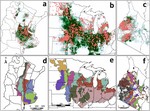Jonathan Ojeda (Jony)
Science & Technology Executive – Carbon Markets & MRV | Scientific Founder @Terradot
[email protected]
Bio
Dynamic and results-driven Science & Technology Executive Leader with over 15 years of experience at the intersection of environmental science, carbon markets, and sustainable agriculture. Proven track record in structuring and executing complex international carbon removal transactions, leading multidisciplinary teams, and securing strategic partnerships. Extensive expertise in project management, stakeholder engagement, and MRV (Monitoring, Reporting, and Verification) implementation for large-scale carbon removal initiatives. Played a pivotal role in raising Series A funding ($58.2M) for Terradot and closing carbon offtake agreements. Strong advocate for integrating ESG (Environmental, Social, and Governance) principles into business strategy, ensuring that sustainability efforts not only drive financial performance but also deliver measurable environmental and social impact. Passionate about leveraging science and technology to accelerate decarbonization, improve land-use efficiency, and promote regenerative agricultural practices. Adept at aligning sustainability initiatives with corporate ESG goals, driving data-driven decision-making, and scaling nature-based and emerging carbon removal solutions to support a resilient and equitable low-carbon economy.
Jony has a deep interest in disentangling sources of uncertainty & spatio-temporal heterogeneity to measure farm productivity & C sequestration in Ag systems. This requires a broad understanding of how environmental factors affect crop growth, how rainfall, irrigation, and applied rock influence soils, and how soil-crop-weather processes interact. Over 15 years of experience managing large soil-crop-climate datasets (>10 years using Python), developing crop/C models & applying data pipelining and optimization towards solving large-scale C deployments. Jony collected (experiments) & analyzed data including >18 crop species (annual, perennials). Jony has 26+ published articles in high-impact journals (13 as first author) and received 18 research grants with a cash value of ~USD6M.
As part of Regrow Ag, Jony led a multicultural global team (15 people including data scientists, software developers/engineers) under the Niche project (USD4M) funded by B&MGF which focuses on the analysis of GxExM in Sub-Saharan Africa. Jony worked with multi-cultural & multi-disciplinary teams (hybrid approach - Academia & Industry) & has ground experience working in 9 countries (Argentina, Brazil, Australia, NZ, USA, The Netherlands, Germany, Rwanda & Kenya).
Interests
- Carbon MRV
- Climate Change
- Decision support tools development
- Sustainable agricultural practices
- MRV Platforms
- Data analytics
Education
PhD in Agricultural Sciences, 2017
National University of Mar del Plata, Argentina
Agricultural Engineer, 2011
National University of Entre Ríos, Argentina




































